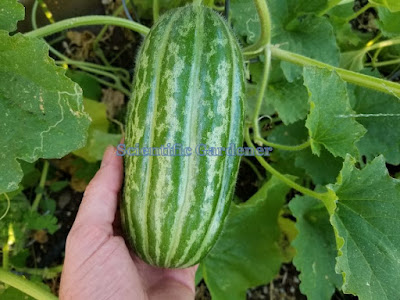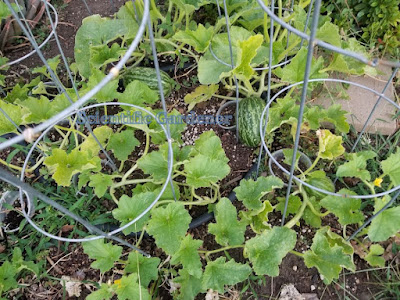While I did stumble upon the checkered Scopattizo carosello back in 2018, the desire for a checkered carosello variety had been a desire of mine for long before that time. Since growing out the Carosello Polisello many years ago, I have been searching for a more mottled cylindrical carosello cucumber to share with others. Unfortunately, the Polisello had major problems with being both polymorphic as well as having some bitterness in the gene. After years of working with the Polisello, I abandoned it in order to focus my efforts on more promising carosello varieties. Another beautiful carosello variety that appeared to have incredible potential for beauty was the Meloncella di San Donato. In addition to its beauty, the variety has a wonderful backstory. Unfortunately, while the San Donato was beautiful, the variety had similar issues with being highly polymorphic, lacking in texture and possessed some bitterness genes as well. So, after growing varieties that would not work, I eventually settled on a sport of a variety that I thought might just work.






While I really do value a level of consistency in each of my cucumber-melon varieties, I am grateful that the seed that I grew out at the chicken garden in 2018 was not fully pure. My goal at the time was to discover a really good Dark Carosello Leccese variety. While I failed to find what I was specifically looking for, from this growout, I was able to select both the Checkered Scopattizo as well as the Splotched Spuredda Leccese (a dark Leccese with bands of light splotching). The first thing that really caught my attention about the fruit of the variety that I now call the Checkered Scopattizo is its very tender texture. From the very moment I saw it, my only desire was to sink my teeth into it. But at the time, the coloring of the fruit was very intriguing to me – and I thought about how nice it would be to be able to save the seed.






I almost lost the plant and the fruit of my tender checkered carosello when I found that the soaker hose that had been watering my plants had been leaking. The puddling up around the vine had caused the roots around the base of the plant to become waterlogged. From my experience, waterlogging the soil is a very fast way to kill off a cucumber or melon. The issue is that, as the vine grows, so do the roots. And not just water wicking roots, but side roots that allow the plant to respirate or breathe under the ground. If these roots are waterlogged, then the plant can develop a vegetative “phenomena” that causes them to deteriorate until they die. After praying over my little plant, I greatly reduced the water to the area and hoped for the best.






Fortunately, the little plant had just enough life remaining to just produce one fruit, which matured just enough to produce viable seed. In order to save the seed, I left the fruit until it nearly rotted and did all I could to keep it from deteriorating as long as possible. In 2019 I took a year off of growing out any checkered variety to see if I could work more with the Spuredda Taratino – which turned out to be more of an Asian pickling variety. After that interlude, I decided to grow out two checkered varieties in 2020 – the San Donato and the Checkered Scopattizo.
In 2020, I found room for the Checkered Scopattizo in a raised garden that I had made. We happened to have some friends living nearby with some room in their front yard, and the raised garden would work well with the situation in their front yard. So – over the winter of 2019 and spring of 2020, I made two raised beds for growing both regular cucumbers and cucumber-melons in.
My experience with the checkered Scopattizo (which I formerly called the Checkered Leccese) in 2020 can be found here.
The primary issue I faced in 2020 was selecting out the deformed flowers and ensuring that I could save seed from the fruit before Powdery Mildew decimated the entire crop. This added a step to the seed processing because, prior to storing the fruit, which was covered in powdery mildew, I had to wash and soak each cucumber-melon in a diluted bleach solution in an attempt to kill off all remaining spores.
In 2021 I once again took a break, but this time it was because I was taking a trip across the country. While I was unable to grow out the checkered carosello variety, I was able to finally grow out the Facussa, which happens to be one of my favorite longer-season varieties.
Finally in 2022, I decided to make growing out the Checkered Carosello variety. Not only because of its colorful appearance, but specifically because – what I had discovered in 2020 – was a very good taste and smooth tender texture. Here is the first video I made in 2022 of the variety.
The first concern I always have with any variety is how well the vines would establish themselves in the garden. Fortunately, the seed of this checkered carosello were vigorous and whatever plants were damaged or maimed were quickly replaced with backup seedlings. I filled in gaps around the China Jade and grew around the plants the best I could. The vines grew quickly. While not as early as many other varieties, I was impressed by the overall health and vigor of the plants.
Once the fruit began setting, I was not disappointed. There was a plant or two that began producing dark female fruit. In these instances, I either pulled the entire plant or pulled all the male flowers from the plant until the fruit was large enough to ensure that it did not match the checkered pattern that I was selecting for. Out of the 30 or so plants, only 2 or 3 ended up having any coloring other than the checkered pattern that I had been selecting for.






Near the end of the season, one of the younger fruits that developed under the China Jade had an interesting appearance. Half of the fruit was dark and the other half was checkered. While I did not want to propagate this type of fruit (I removed the male flowers so that it would not cross with my other checkered varieties) I thought the color was really fun.






Other than some rodent damage to some of the fruit, which I pulled and left out for the rodents to finish off, the plants and fruit developed without incident. The color, texture and taste of the variety are all that I could have ever asked for. Here is the last garden video I made about this variety in 2022.
The name of this variety, other than being checkered, was a little difficult. But given the heavily scalloped shape, pattern and the dark color of its off-type fruit – I could only assume that the original fruit that this variety came from was a Scopattizo Barese. I wanted to keep the essence of the variety, without pronouncing an origin, so I refer to this variety as the Checkered Carosello Scopattizo, the Checkered Scopattizo or just “Chex” – which is a shortened version of the English word “Checkered”. For a full explanation of how I worked to select this variety and more of the reasoning behind the name, you can see my YouTube video.





In short, the Checkered Scopattizo, or Chex ended up being everything that I hoped it would be. Beautiful, delicious and fine textured – this carosello cucumber variety is a perfect variety on its own or in combination with the productive and delicious Striped, Light and Scuro Leccese.





















































































